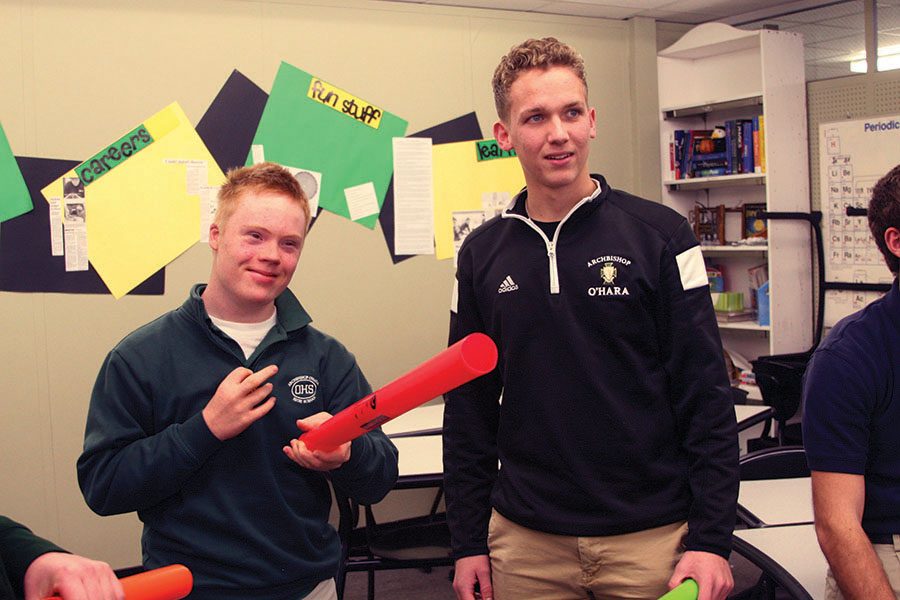Paraprofessionals, peer mentors and trailblazing: An exploration of area Special Education programs
The Dart takes a look at various special needs education programs around the area, exploring the similarities and differences between public and private schools.
story by Linden O’Brien-Williams and Alex Davis
It was a September afternoon when Nathan’s parents walked into the office of Elizabeth Baker, former principal of Nativity of St. Mary’s School in Independence and current STA principal of student affairs, to ask her an important question.
“Our son has been diagnosed with autism, and we want him to go to a Catholic school. Our daughter is going to go to St. Mary’s. Can you do that?”
A program for students with special needs at St. Mary’s was unprecedented – no protocol, no instruction manual. At the time, Baker had limited knowledge or experience with special education. But, she wanted to help, so she did some research.
After contacting his previous school, Baker found Nathan would need an aid to attend St. Mary’s, as well as the approval of the school board.
St. Mary’s said yes – the school and parish were willing to “take on the expense of having this child come” and begin St. Mary’s program for students with special needs. However, upon approval from the board, Baker faced her next challenges: how to incorporate a student with special needs into a private school space when no other school in the area had done it before. What would it take to make sure those students were receiving an adequate education? How would a private school program compare to the established public school program?
– WHAT IS FIRE? –
Nathan’s admittance was the first of many students with special needs at Nativity of Mary School. Among those students was one of Baker’s relatives: Brett Hughes, son of Jeff and Michele Hughes.
“[Michele] was really struggling with the Catholic grade school that he was at in terms of understanding how to teach a student with Down syndrome,” Baker said. “[She asked if] we could enroll him and if his FIRE money would follow him. And I’m like, ‘FIRE money? What are you talking about?’”
The Hughes were one of the founding families of FIRE – the Foundation for Inclusive Religious Education. Founded in 1996 by the families of six students with special needs, the FIRE Foundation is an independent organization that “makes it possible for partner Catholic schools to hire special educators and paraprofessionals and to acquire learning materials and technology that create successful learning experiences for all children,” according to its website.
Maura Nulton and Mary Anne Hammond were among those founding families. Both have children with special needs, Charlie Nulton, 21, and Kailey Hammond, 23. Hammond recalls the moment that spurred the movement.
“We had just moved to Kansas City,” Hammond said. “We were sitting at mass on a holy day…after mass was over, Maura kept asking me about Kailey. ‘Where is she going to school?’ and I thought ‘I have no idea.’”
When Hammond asked Nulton about schools for Charlie, Nulton replied that she wanted him to go “here, to St. Peter’s.” But, there was no established program for special needs students in the diocese.
After a brainstorming session with area parents wanting to send their students with special needs to faith-oriented schools, six families came together to form what is now known as FIRE. These six “founding families” – the Nultons, Hammonds, Costanzos, Hughes, Levis and Dearths – would forge the path to include their children with special needs in Catholic parish schools.
“In the early years, it was pretty emotional,” Hammond said. “We wanted this for our kids and we knew it could be done, but we didn’t know how it would be done.”
“We talked to everyone about it,” Nulton said. “What we found was people kind of wanted to get on board. That’s how it got momentum. We just had two schools to start out with… We’d love to be in every school.”
Since its founding in 1996, FIRE has expanded drastically. According to FIRE’s website, 158 students with special needs will learn with their peers at 13 schools for the 2016 – 2017 school year. 541 students also receive support from trained paraprofessionals. In total, FIRE has benefitted 4,864 students at partner schools with inclusive learning.
– ARCHBISHOP O’HARA HIGH SCHOOL –
Archbishop O’Hara High School opened its door to special needs students in 2007 with its founding of their OPTIONS program. Initially driven by FIRE, O’Hara administration hired couple Steve and Nancy McCoy, retired teachers from the Hickman Mills district with experience in special education.
Principal Jane Shafer, vice-principal at the time, researched programs across the nation. Shafer found several schools who utilized peer mentor programs and decided that method would fit O’Hara. McCoy is glad O’Hara uses a peer mentoring program rather than a paraprofessional program.
“We know from studies and from fact that students learn so much more from their peers socially, spiritually and academically than from an adult who is breathing down their neck all the time,” Nancy McCoy said. “And the growth we’ve seen from having peer mentors… is just tremendous because [the students with special needs] are more inclined to be independent with our peer mentors.”
The OPTIONS program is an elective course available to juniors and seniors only. Students participating in the class are graded and must meet expectations in order to continue as peer mentors. The program is largely student-run – six seniors, or “head mentors,” lead day-to-day operations, meetings, or even design curriculum to teach students to drive. In total, around 40 students of O’Hara’s student body of under 300 students are peer mentors, meaning they spend one class period a day with one or more students with special needs, as a comforting presence ready to answer questions, guide note-taking, or keep behavior in check.
To be considered for a peer mentor position in the OPTIONS Program, students undergo a rigorous application process involving an application form, written responses, teacher recommendations and GPA requirements. There is also a mandatory peer mentoring training in the summer, wherein the mentors sign a confidentiality form.
During the application process, McCoy stresses the level of maturity the student must have.
Savannah Gray, O’Hara senior lead mentor and communications and advancements leader, notes the peer mentors are not distracted from their own courses, but instead are wholly involved in supporting the student they are mentoring.
“You’re not worried about your own class and learning, you’re focused on their grade and how they’re understanding,” Gray said.
Having peer mentors also adds another layer of social development for students with special needs. Co-vice life skills directors and O’Hara seniors Tommy Wagner and Ryan Rieger explain the importance of equal ranking and how it plays into the students’ interactions.
“Most of the students in grade school had to listen to their parents all the time and then they had a paraprofessional,” Wagner said. “With us, it’s just a friend helping us help them.”
“…Let’s say you have a student with special needs who is a senior,” Rieger said. “You wouldn’t want a freshman being their peer mentor because that’s kind of a hit to their integrity.”
As O’Hara transitions to its new location, St. Michael the Archangel, so will the OPTIONS Program. The program will undergo rebranding and will be called the SMILE Center. SMILE, St. Michael’s Inclusive Learning Enhancement, will be the same concept as OPTIONS, aside from the new location and classroom setting.
photos by Cassie Hayes
– SHAWNEE MISSION EAST AND OTHER PUBLIC SCHOOLS –
All her life, Pete Whittaker’s mom attended Catholic school and wanted her children to do the same, so she decided on St. Elizabeth’s School. At times, Debbie Whittaker was tempted to move her whole family west just a few hundred feet for access to the Shawnee Mission school district. The public school district presented an easy out – a school with an allocated budget, a school with an established program for students like Pete.
But, Debbie “never in [her] heart felt that that was the right decision.” Her case was different than some – a couple years after Pete was born, his father passed away. Debbie was moved by the outpouring support from the St. Elizabeth’s Parish and felt it would be wrong to uproot her two older daughters, STA alumna Maureen and current sophomore Lucy.
In Debbie’s view, sending her son with special needs to a public school meant giving up control over the process that she couldn’t give up. Even though Pete was the first kid with Down syndrome ever to go to St. Elizabeth’s School, she believes the challenges were worth it.
“… I think it’s a double edged sword – you have a lot more input I think in the private schools on your child’s plan, but the people you’re working with don’t have as much experience,” Debbie said.
When examining the differences between public and private schools in general, the issue of funding no doubt plays a role. For non-diocesan and diocesan schools alike, there is no federal or state money for students with special needs, or even a governing body that dictates a necessary program. However, at Shawnee Mission East High School, the program is government-mandated. The Shawnee Mission school district also has an allocated budget for special education programs in the various schools.
At SME, the program comes close to O’Hara’s through classes like the “Special Skills” class, taught by math teacher Andy Walter, alongside two special education teachers and a school social worker.
The Special Skills class “is a class that has regular education students and special education students together.” The curriculum, he says, is tailored to the students in it. Some students are working on leadership skills, some on workplace skills, but everyone, he says “is working together on academic skills.” Along with that, schedules are custom made for each student by various educators, administrators and the student’s parents to ensure that the students interact with the school body “as much as is appropriate.” One main difference between the Catholic school model in Kansas City and the model at East is the use of paraprofessionals. At East, they are present, but at O’Hara, the peer mentors take on that role.
Responding to Debbie’s sentiment that programs at public schools are not specialized enough for the individual, Walter believes issues with special needs programs at public schools are not due to a disregard for a student’s individual flourishing. He believes “we really work hard to make an individualized program for every kid… We may fall short at times, but it’s not due to lack of effort.”
On top of allocated state funds, SME has the “East Fund” – an institution with grants that “allow our educators, students, and patrons of SME to apply for funding for professional development, classroom programs, and technology. ”
The fund allows SME to operate the Columbia Brew coffee shop, a fully functioning coffee shop inside East’s walls, operated all by students with special needs to practice with life skills. This coffee shop is similar to one operated at O’Hara Wednesday mornings.
Similar to the East Fund, the tax-exempt FIRE foundation requires schools to go through a formal grant application in order to be considered for aid, which comes from extensive fundraising and donations. In order to maintain the grant, an appeal to the board must be made annually. In most cases, the grant amount is limited.
For Debbie, Nulton and Hammond, the faith community makes all the difference.
“There are great public schools, but for the Nultons and for many people, I want my children to be able to pray from the moment they open their eyes until they go to bed at night and anytime they want to talk to God or to talk about God, I want them to have that opportunity,” Nulton said. “It just fits with Catholic education…”
– SPECIAL EDUCATION AT STA –
Just a few weeks ago, STA continued its annual tradition of hosting eighth graders on a January morning to take the four-hour HSPT, or High School Placement Test. According to STA president Nan Bone, STA’s admissions process is such that the HSPT is required of all students wishing to begin studies at STA. Students are then admitted based on scores. According to Baker, students at O’Hara do not take the HSPT. Bone describes how the HSPT could hinder a student with severe special needs from attending STA.
“The students that we can take that have needs are students that need extended time testing, dyslexic students, students that are on a [504 plan],” Bone said.
The 504 plan, according to Great Schools, is an anti-discriminatory plan put forth by the federal government that supports students with disabilities. Bone notes that the 504 plan is common, and is usually for less severe learning disabilities, but can also include learning, behavior or health-related conditions. To contrast, an IEP, which most students with severe special needs have, is a document detailing a plan for a student who, by law, qualifies for special education, rather than general education.
Bone says that while it is unlikely STA would have the resources to provide an adequate education for a student with an IEP, the school does meet with parents of students who have IEPs to see what could be done. If the school is not “able or equipped to take certain severe IEP cases,” it will refer parents to the Kansas City public school district.
However, some IEP cases, along with multiple 504 plans, are able to be met. STA’s established infrastructure and resources for these students includes a recently added full-time nurse and on-call counselors.
A term in the special education community is “accommodations and modifications,” according to Baker. This idea of accommodating the need and modifying the setting to suit the student, she says, is another way in which STA incorporates students with 504 plan needs at STA. Modifications can look like having a padded chair ready for a student who uses a wheelchair, and accommodating them to learn comfortably.
Hammond and Nulton, while wholly content with O’Hara’s OPTIONS program, express that STA is missing an opportunity due to its lack of students with special needs. Hammond remarks that for regular education college applicants, involvement in something like the peer mentor program at O’Hara “will then set them apart from others, which is really what we want every potential college applicant to do.”
Hammond also says that O’Hara’s peer mentors “tell impressive stories of leadership and compassion and inclusion.” Nulton believes that this development of young men and women of STA and other non-diocesan schools “spiritually, mentally, emotionally, physically” would be complimented greatly by inclusive education similar to what is found at O’Hara.
Both Baker and Bone remark that while STA’s current structure does not include a program for students with special needs, STA is not necessarily opposed to something of the sort down the road.
The distinction is that while STA’s curriculum is purely academic at this point, schools with special education programs have both an academic curriculum and a separate curriculum more about functional needs and practical life skills. STA, as of now, simply does not have the department for such a program, which would require hiring new teachers and the establishment of an entire resource center, among other things, according to Bone.
“What I would say is it’s a 360-degree difference in what we’re doing now,” Bone said. “It would take years…”
“It’s just like going from here to here,” she said, moving her hands from one side of her desk to the other. “But we are here in the middle, doing as much as we can to incorporate the needs of the students that we can.”
alternative coverage by Julia Kerrigan
Terms to Know: the Dart defines important terminology from the center spread story. Definitions courtesy of Merriam-Webster Dictionary.
Autism a variable developmental disorder that appears by age three and is characterized by impairment of ability to form normal social relationships, by impairment of the ability to communicate with others, and by repetitive behavior patterns.
Down Syndrome A few of the common physical traits of Down syndrome are low muscle tone, small stature, an upward slant to the eyes, and a single deep crease across the center of the palm.
Dyslexia a variable often familial learning disability involving difficulties in acquiring and processing language typically manifested by a lack of proficiency in reading, spelling and writing.
Paraprofessional a person to whom a particular aspect of a professional task is delegated but who is not licensed to practice as a fully qualified professional.
501(c)3 a tax exempt non-profit organization.
*Editors Note: A previous version of this story included an outdated definition of Down Syndrome. The definition has been updated and the Dart staff deeply regrets this error. We would encourage our readers to learn more about Down Syndrome through the following organizations:
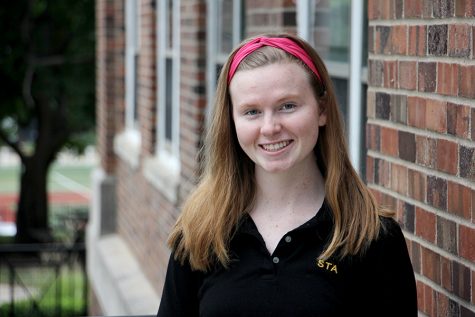
Hello there!
It seems you’ve stumbled upon the DNO staff profile of Linden O’Brien-Williams, co-editor-in-chief of the Dart and DartNewsOnline....
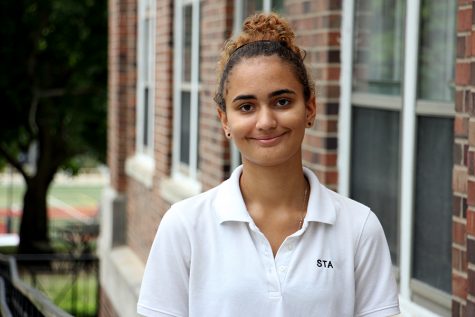
Hello! My name is Alex Davis, and I am the staff videographer and multimedia editor for the Dart. I've been a Dart staffer since 2014, and sadly this will...
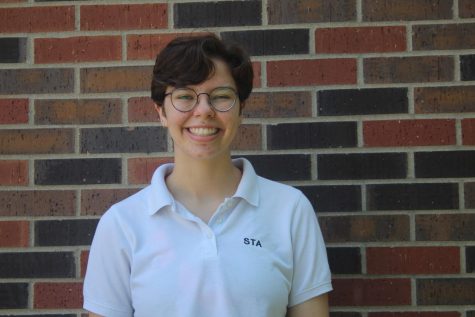
Hello! I’m Julia Kerrigan, co Editor-in-chief. I’m so excited to be on this staff for a third year so I can keep making content in the form of stories,...
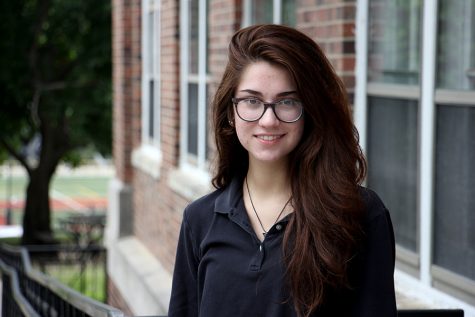
Hey there, I’m Cassie Hayes, a senior and a second year staffer for the Dart. This year I’ll be serving up some sick photowork as one of your photo...



